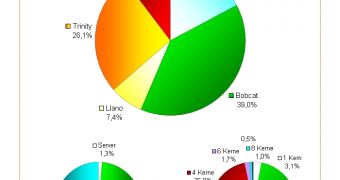Pretty soon, there might not be any AMD central processing units without integrated graphics processing units, save for some server and supercomputer models. The company's sales results for the third quarter of 2012 suggest as much.
The situation that Advanced Micro Devices finds itself in is somewhat precarious, despite the relatively good news that we have to impart this time.
And by good news, we mean that the company's decision to bet heavily on accelerated processing units (CPUs with Radeon integrated graphics) is paying off.
During the third quarter of the ongoing year (2012), the Sunnyvale, California-based company sold 15.4 million processors.
"Bobcat" Zacate series low-power APUs for laptops were the most popular (4.7 million), followed by Desktop Phenom / Athlon X2 chips (2 million) and Desktop Bobcat (1.3 million).
Quad-core Trinity APUs follow, with 1.038 million shipments, and dual-core Trinity almost reached the same level (1.022 million).
The reasons that CPU shipments aren't even close to these figures aren't all that strange. Bulldozer and K10/10.5 architectures are a bit outdated, Bulldozer wasn't much to look at in the first place, the Desktop Phenom X4 isn't around anymore, and Vishera is such a recent arrival that it wasn't even included in the tally.
All things considered, it is doubtful that AMD will keep on trying to sell desktop and laptop processors without integrated GPUs of some kind.
That leaves the server segment, which isn't much to look at. While the mobile and desktop branches each attained shipments of 7.4-7.7 million, AMD only sold around 200 thousand server processors.
All in all, out of all the chips that AMD shipped between July and September 2012, 75% were accelerated processing units.
The percentage will probably grow this quarter (October-December, the winter holiday season). Vishera Piledriver 8-core chips might have enough influence to cause the opposite, but it falls to time to show which way things go from here.

 14 DAY TRIAL //
14 DAY TRIAL //